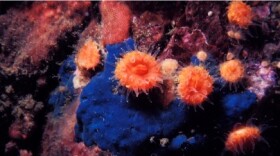In the long saga to protect the northern spotted owl, it's now officially "owl vs owl."
US Fish and Wildlife says the decline of the iconic northwest species can’t be helped without killing some of its more aggressive cousins, the barred owl.
It’s part of a court-ordered plan to increase the spotted owl’s forest habitat.
Despite millions of acres of forest set asides, and the silencing of many mill towns in the northwest, the northern spotted owl population has continued to decline.
Their numbers have slid by 40 percent in the past 25 years.
“So we don’t believe that a hands off approach to critical habitat is the right approach for spotted owl recovery,” said US Fish and Wildlife director Dan Ashe, as he announced a new 3-part plan to bring spotted owls back from the brink of extinction.
“We need to protect the best of its remaining old-growth habitat. We need to actively manage forest landscapes to restore their health. And we need to manage competition from the barred owl.”
Barred owls are an invasive species from the east coast.
They’ve followed human development and crowded out their meeker cousins.
The proposal includes plans to shoot the barred owl in some areas, to see if that helps bring back their native northern cousins.
It’s a controversial plan – and one that still leaves many questions unanswered.
“What level of intensity do you need to do it at and for how long? Is this a permanent program? Instead of providing more habitat for spotted owls, we’ll just go out and shoot barred owls?” asks Sean Cantrell, Executive Director of Seattle Audubon.
After much hand-wringing, Audubon has come out in favor of the plan, because, Cantrell says, clearly something new has to be done.
But he says the devil’s in the details. They don’t know yet which millions of acres in the northwest will be designated as critical habitat. It’s not clear yet that the barred owl removals would actually help. And they don’t want to see the experimental killing become permanent.
“That doesn’t seem like a sustainable solution, nor a desirable one,” Cantrell says.
Fish and Wildlife says their approach will be careful and incremental, and based on science, with equal focus on managing forests to increase prey populations that spotted owls feed on and to prevent wildfires that often rip through their rare nesting areas.
They say this new plan has the added benefit of creating timber jobs.
Comments on the plan's environmental impact statement will be taken as soon as it is released, which is expected in mid-March. The executive summary for the draft plan is currently available here.







